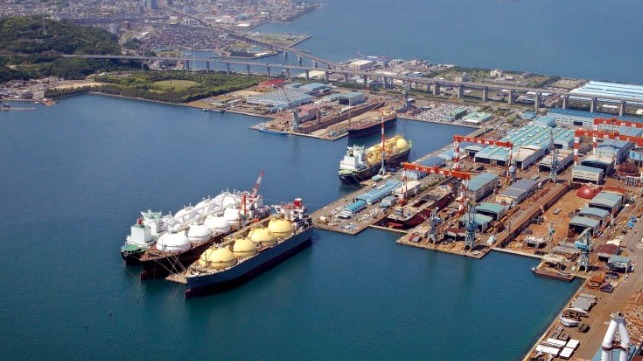Kawasaki Plans to Focus on Hydrogen Shipping Moving LPG Work to China

In an effort to lower costs for basic parts of the shipbuilding process, and focus on the emerging hydrogen market, Japan’s Kawasaki Heavy Industries is planning to shift construction work to a joint-venture shipyard in China. The efforts are designed to enhance the shipbuilder’s position on its standard gas tankers while the yard in Japan would move to newer segments where the yard has a competitive advantage.
According to reports from Nikkei Asia, Kawasaki plans to move the structural construction components for the hull of liquefied petroleum gas tankers from the Sakaide shipyard in western Japan to the company’s joint venture shipyard Nantong Cosco KHI Ship Engineering (NACKS) run in partnership with Chinese state-owned COSCO Group. Construction of the hulls and structural elements of gas carriers will be built in China enabling Kawasaki to lower production costs and improve profits on the newbuilds. The hulls will be transferred to the Sakaide Works where Kawasaki-built engines will be installed and the outfitting completed.
Kawasaki currently has orders for seven LPG tankers due for delivery over the next two years. Nikkei reports that the plan is to transition future work by the end of the current decade to the NACKS yard.
Japanese shipbuilders have been struggling to keep up with the rapid growth of competitors in China and South Korea. Shipbuilders in those two countries recently have been receiving 80 percent or more of the new orders while Japanese shipyards represent less than 10 percent of recent orders. Nikkei reports that Kawasaski’s total order book grew over 22 percent this year with a current value of nearly $1 billion.
Kawasaki has been building ships at its Kobe yard for 135 years. The company builds a broad range of ships, including tankers, containerships, and bulk carriers as well as naval vessels. The Sakaide Shipyard was launched in 1967 focusing on the construction of larger ships. Recently the yard has been responsible for the construction and repair of LNG and LPG carriers and other large ships.
NACKS was established as a joint venture between Kawasaki Heavy Industries and China Ocean Shipping (Group) Company (COSCO) in December 1995. The new shipbuilding enterprise has grown to become one of the leaders in China.
Recently, Kawasaki has begun to increase its research and development efforts focusing on the emerging market for hydrogen shipping. In May 2021, the Japanese government announced that it would establish a $3 billion fund to support the development of the hydrogen supply chain.
Kawasaki recently received an AiP from ClassNK for a cargo containment system (CCS) for a large liquefied hydrogen carrier. The new concepts for the containment system utilize a new type of insulation structure that uses a high-performance heat insulation system that mitigates boil-off gas (BOG). Kawasaki also announced that it is currently developing the design for a large, 160,000 m3 liquefied hydrogen carrier that would use four CCS tanks. They expect that this vessel could start commercial operations by the mid-2020s.
